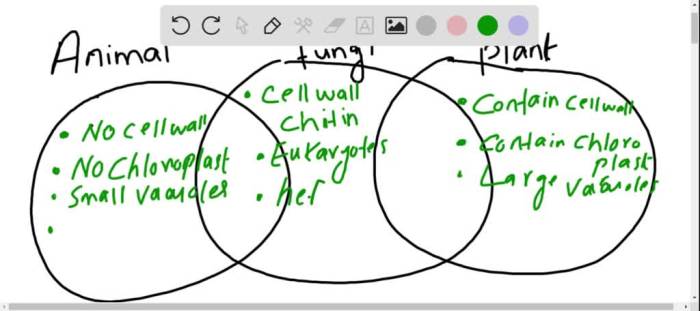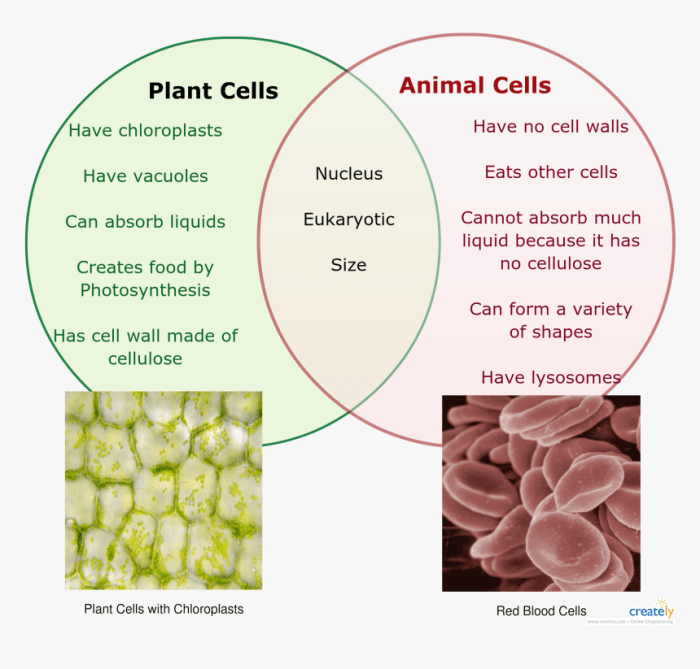Venn diagram animals and plants – Venn diagrams are visual representations that compare and contrast two or more sets. In the context of biology, a Venn diagram can be used to illustrate the similarities and differences between animals and plants. This diagram highlights the shared characteristics that define life, while also emphasizing the unique adaptations that distinguish these two kingdoms.
Animals and plants are both living organisms, sharing fundamental cellular structures, metabolic processes, and the ability to respond to stimuli. However, animals possess unique traits such as locomotion, heterotrophy, and specialized sensory organs, which set them apart from plants.
Animal and Plant Similarities

Animals and plants share several fundamental characteristics that define them as living organisms. These similarities include:
- Cellular Structure:Both animals and plants are composed of cells, the basic units of life. These cells have a similar structure, including a cell membrane, cytoplasm, and DNA.
- Metabolism:Animals and plants both undergo metabolism, the chemical processes that sustain life. This includes the breakdown of nutrients to release energy and the synthesis of new molecules.
- Response to Stimuli:Both animals and plants can respond to external stimuli. Animals typically respond with movement or behavior, while plants respond with growth or chemical changes.
The concept of “life” encompasses these shared characteristics. Living organisms are defined by their ability to maintain homeostasis, reproduce, and adapt to their environment. Both animals and plants meet these criteria, demonstrating their fundamental similarities as living beings.
Animal and Plant Differences
Despite their similarities, animals and plants also have distinct characteristics that differentiate them:
Locomotion
Animals are motile, meaning they can move from one place to another. This ability is facilitated by specialized structures such as muscles and bones. Plants, on the other hand, are sessile and cannot move.
Heterotrophy and Autotrophy
Animals are heterotrophs, meaning they must consume other organisms to obtain energy. Plants, in contrast, are autotrophs and can produce their own food through photosynthesis.
Sensory Organs
Animals possess specialized sensory organs that allow them to perceive their surroundings. These include eyes, ears, and taste buds. Plants lack such complex sensory organs but can still respond to environmental cues through chemical and physical signals.
Interactions between Animals and Plants: Venn Diagram Animals And Plants

Animals and plants interact in various ways, including:
Mutualism
Mutualism is a symbiotic relationship in which both species benefit from the interaction. For example, bees pollinate flowers, enabling plants to reproduce, while bees obtain nectar for food.
Commensalism, Venn diagram animals and plants
Commensalism is a symbiotic relationship in which one species benefits from the interaction without harming the other. For instance, epiphytic plants grow on trees, using them as support without causing any harm.
Parasitism
Parasitism is a symbiotic relationship in which one species (the parasite) benefits at the expense of the other (the host). For example, mistletoe plants attach themselves to trees and obtain nutrients from their host.
The Role of Animals and Plants in Ecosystems
Animals and plants play crucial roles in ecosystems:
Nutrient Cycling
Animals consume plants and other animals, breaking down organic matter and releasing nutrients back into the environment. Plants, in turn, absorb these nutrients from the soil.
Energy Flow
Animals consume plants and other animals, transferring energy through food chains and webs. This energy flow supports the entire ecosystem.
Habitat Provision
Animals and plants provide shelter and habitat for each other. For example, trees provide nesting sites for birds, while animals create burrows and dens that serve as shelter for other species.
Biodiversity
The diversity of animals and plants is essential for maintaining healthy ecosystems. Biodiversity ensures resilience, adaptability, and stability in the face of environmental changes.
FAQ Insights
What is the main difference between animals and plants?
Animals are heterotrophic, meaning they must consume other organisms for energy, while plants are autotrophic, meaning they can produce their own food through photosynthesis.
What are some examples of symbiotic relationships between animals and plants?
Mutualism: Both species benefit from the interaction (e.g., bees pollinating flowers). Commensalism: One species benefits while the other is unaffected (e.g., barnacles attaching to whales). Parasitism: One species benefits at the expense of the other (e.g.,
tapeworms living in animal intestines).
How do animals and plants contribute to ecosystems?
Animals play crucial roles in nutrient cycling, energy flow, and seed dispersal. Plants provide food, shelter, and oxygen for animals, and they contribute to soil formation and water regulation.

